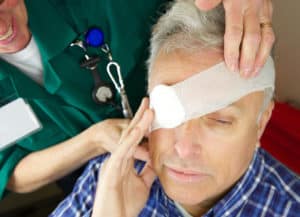Eye Injury

Humans are visual creatures. According to some studies, 80% of the information used by your brain comes through your eyes. When something affects your vision, the ways you experience the world and communicate will change dramatically.
Eye injuries cover a wide range of injuries to the eye tissue and the surrounding bones, muscles, nerves, and blood vessels. They can result in various symptoms that reduce your visual acuity or even cause temporary or permanent blindness.
Read on for an overview of eye injuries and how you can seek injury compensation for the physical, mental, and economic effects of one.
Table of Contents
What is the Structure and Function of the Eye?

The brain gathers information using the sense organs. Your eyes, nose, ears, tongue, and skin give your brain the information to form an image of the environment.
Your eyes use light to create a visual image. Light enters the eyeball or globe through the cornea, which protects the front of the eye from injury and infection. It also focuses light entering the eye.
Light passes through the pupil. The iris controls the pupil to allow a measured amount of light into the globe. In low light, the iris dilates the pupils. In bright light, the iris contracts the pupils. This protects the eyes from overexposure to light while allowing enough light to see.
After passing through the pupil, light travels through the lens. Muscles in your eye reshape the lens to further focus the light entering the eye to form a sharp image on the retina.
The retina is a specialized nerve that sits at the back of your globe. It has light receptor cells that sense white, black, and colors. This information travels along the optic nerve to the brain. The brain interprets the information to create a visual image.
What Causes an Eye Injury?
Your eyes can suffer many types of injuries in an accident. Some causes of injuries include:
Blunt Force
Blunt force injuries happen when you get hit in the eye without causing an open wound. You will likely suffer a blunt force injury if you hit your face and eye after a slip and fall accident.
Penetrating Force
Penetrating force injuries happen when something pierces your eye or the surrounding tissue, causing an open wound. A piece of a tool that gets propelled into your eye in a workplace accident might cause a penetrating injury.
Foreign Substances
Foreign substances in your eye can cause considerable pain and damage.
Substances in your eye could include:
- Particles
- Chemicals
- Objects that hit but fail to penetrate your globe
Almost any accident can cause foreign substances to enter your eyes, from engine fluids in a car accident to gravel and dirt in a motorcycle accident.
What Are Some Examples of an Eye Injury?
Eye injuries can take many forms depending on the tissue that gets damaged. Some examples of eye injuries include:
Scratched Cornea
One of the most common injuries is a scratched cornea. This can happen from debris in the eye. It can also occur when something scratches across the eye without penetrating the globe.
Symptoms of a scratched cornea include:
- Pain
- Redness
- Blurry vision
- Watery eyes
Most corneal abrasions heal on their own in a few days. Severe corneal abrasions may require a visit to the doctor for an examination to ensure that no debris remains in the eye. Doctors might also prescribe antibiotic eye drops to prevent or treat eye infections from a scratched cornea.
Chemical Burn
Burns happen when a chemical reaction destroys cells. If you get caustic chemicals in your eye, the resulting chemical burn can destroy the structures of your eye and diminish or destroy your vision.
First aid is often critical. If you can quickly flush the chemicals out of your eye, you might preserve at least some of your vision.
Fractured Orbital
The orbital includes the bone that surrounds the eye. In an accident, you can fracture this bone. A fractured orbital can permanently affect your vision.
If the bones heal out of alignment, your eye might not align, leading to double-vision. Bone fragments can sever or get tangled in the muscles that move the eye. This can limit the movement of your eye.
In a worst-case situation, bone fragments can sever the blood vessels or optic nerve. If the blood vessels die, your retina could die, and you could become blind. If the optic nerve gets severed, images formed in your eye will never reach your brain, and you will lose your vision.
Ruptured Globe
A ruptured globe happens when an object penetrates the eyeball. The object can damage the structures of the eye. For example, the object can tear the retina, causing partial or total blindness. Also, fluid in the eye can leak out of the tear and further damage the eye.
Doctors can treat a ruptured globe by closing the tear. But a ruptured globe almost always leads to at least some vision loss.
What Compensation Can You Get for an Eye Injury?
If you suffer an eye injury in an accident caused by someone else, you can seek personal injury compensation. The compensation you can seek can cover both your economic and non-economic losses.
Because humans rely so heavily on the eyes, an eye injury can disrupt your life in many ways. You will likely require treatment and corrective lenses to try to restore at least some of your vision. You might need to change jobs or retrain for the job you have. All of these changes could have substantial economic costs.
On top of the economic costs of an eye injury, you might suffer pain and mental anguish. Eye injuries are often painful, and losing some or all of your vision can cause depression and anxiety. You will not be able to participate in activities as you did before your injury. You may even suffer permanent disabilities.To discuss the compensation you can seek for these and other effects of your eye injury, contact or call M&Y Personal Injury Lawyers at 866-864-5477 for a free consultation.
